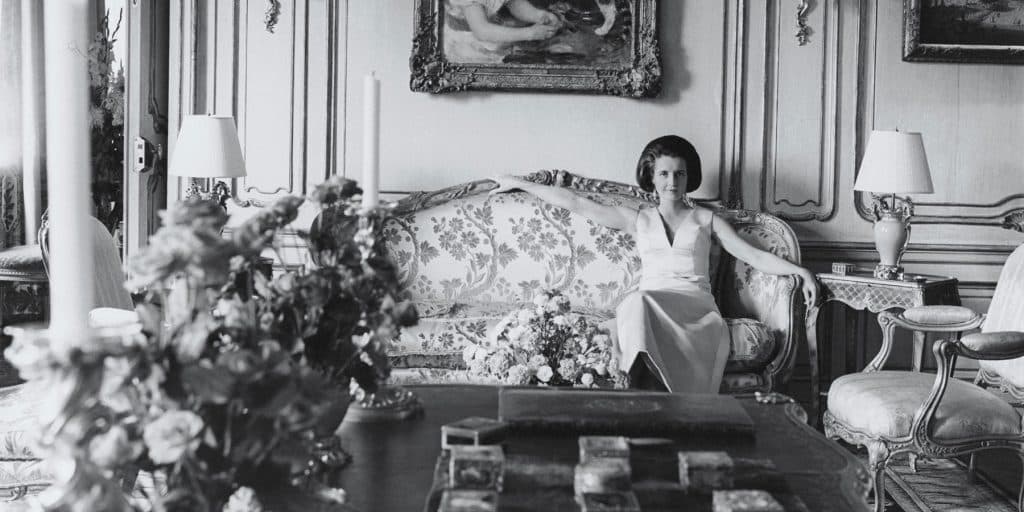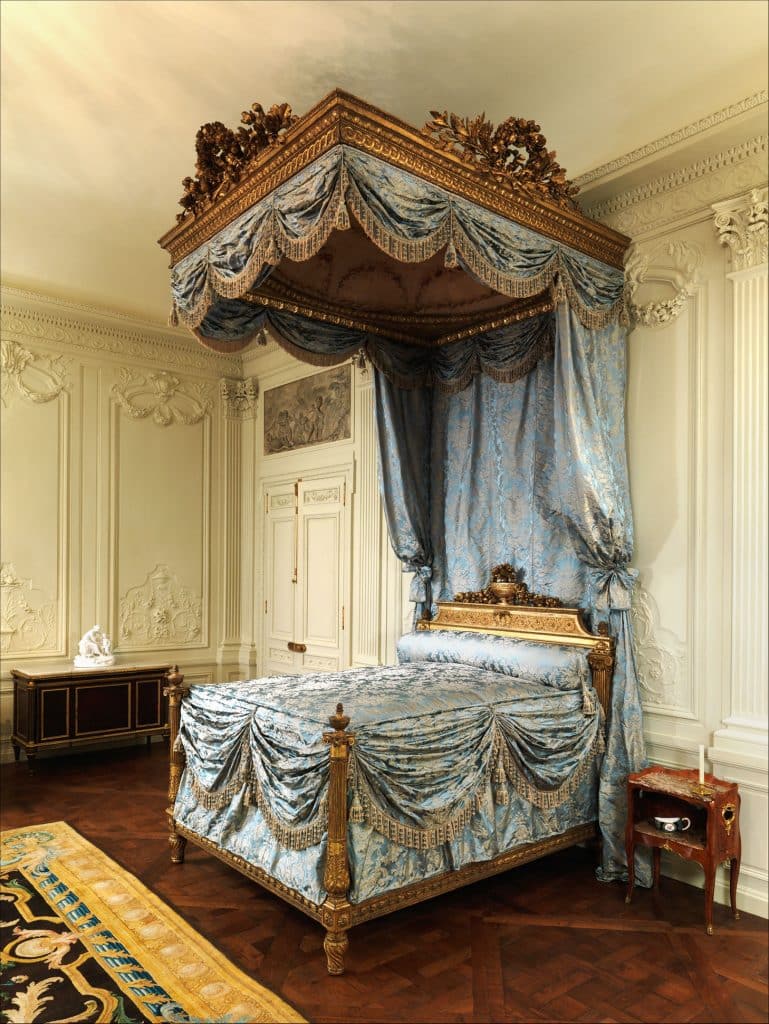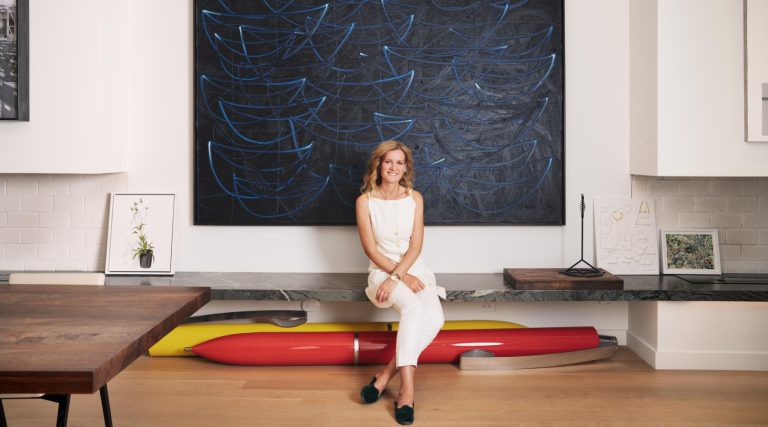
April 28, 2019Style icon and philanthropist Jayne Wrightsman is remembered for her art, French furniture, porcelain and clothing collections, most of which she donated to museums like the Metropolitan. Soon after Wrightsman’s husband, Charles, was made a trustee of that museum, the couple was inducted into high society’s inner circle (photo by Cecil Beaton © Conde Nast). Above: First Lady Jacqueline Kennedy and Wrightsman at the Biltmore Hotel in Palm Beach, Florida (photo by Morgan Collection/Getty Images).
New York society doyenne Jayne Wrightsman, who died earlier this month at age 99, was an arts patron, a sparkling hostess of A-list dinner parties, a couture-clad member of the International Best-Dressed List and a rail-thin beauty who created sumptuous homes for herself and her husband in New York, Palm Beach and London.
She was the widow of Charles B. Wrightsman, an Oklahoma-born oil tycoon and dashing polo player whom she married in 1944 when she was 24. He was then 48, the president of Standard Oil in Kansas and a divorced father of two.
Socially ambitious, Charles started seriously collecting 18th-century French antiques and French decorative arts. For 40 years, the couple traveled the world acquiring museum-quality pieces of FFF (fine French furniture), porcelain and Old Masters for their homes. These included an 18-room apartment at the formidable 820 Fifth Avenue; a flat at 21 St. James Place, near Spencer House, in London (whose contents Sotheby’s sold in 2010); and Bythedunes, a Maurice Fatio–designed Mediterranean-inspired mansion in Palm Beach.
All three were decorated by the fashionable Parisian decorators Stephane Boudin, of Jansen, and Henri Samuel. (In Palm Beach, the Wrightsmans became close friends with their neighbors John and Jacqueline Kennedy, and the First Lady later asked for Wrightsman’s help in restoring the White House.)

Like the rest of the Wrightsman’s Palm Beach house, the grand salon was the work of design masters Syrie Maugham, Stéphane Boudin, Henri Samuel and Vincent Fourcade. As Emily Evans Eerdmans explains in Henri Samuel: Master of the French Interior (Rizzoli), the couple’s attraction to Samuel was unsurprising, given his extensive experience with curator Gérald Van der Kemp at Versailles. Photo by Feliciano

A young Jayne Wrightsman with her poodle. Photo by Ray Howard/Palm Beach Post/Zuma Press
Ever generous, Charles was made a trustee of the Metropolitan Museum of Art in 1956, serving until 1975. The Wrightsmans’ social circle came to include Bernard Berenson, John Pope-Hennessy, Kenneth Clark and Met curator James Draper. Jayne’s friends included the Duchess of Devonshire, Brooke Astor, Bunny Mellon and Katharine Graham, the publisher of the Washington Post.
Jayne never attended college (after high school in Los Angeles, the Michigan-born beauty modeled bathing suits and worked at a department store), but once married, she learned French and devoted herself to the study of French decorative arts. Over time, she made contacts with leading experts in the field, such as Sir Francis Watson, director of London’s Wallace Collection; Pierre Verlet, of the Louvre; and Everett Fahy, chairman of the Met’s department of European paintings.
Jayne Wrightsman created a lasting legacy through her decades of devotion and contributions to the Met. She and her husband gave the museum hundreds of works, from couture gowns to porcelain, gilt bronzes, antique furniture, paintings and sculpture. Today, she is fondly remembered by the Met’s staff as a thoughtful, curious and caring patron.
After her husband died, in 1986, the publicity-shy doyenne was not afraid to be seen roaming the museum rooms devoted to French decorative arts of the late 17th to the late 18th century, which came to be called the Wrightsman Galleries. Beside her many donations, she was famous for supporting “invisible” improvements like the purchase of new textiles, lighting and reupholstering.
In 2006, when the Met staged the show “Dangerous Liaisons: Fashion and Furniture in the 18th century” in the Wrightsman Galleries, it hired Patrick Kinmonth, an Anglo-Irish opera director and designer, as a consultant. Kinmonth worked with a lighting designer who bathed the mannequins in a soft light (to imitate candlelight) that made the costumes glow. Jayne loved it.

The Met’s period rooms devoted to French decorative arts of the late 17th to the late 18th century, named the Wrightsman Galleries in recognition of the couple’s generosity, are perennially popular with decorative-arts obsessives. In 1963, the Wrightsmans donated the boiserie shown here, from the Hôtel de Varengeville, in Paris. The high-relief carvings on the painted and gilded oak paneling conjure a dramatic lavishness. Photo courtesy of The Metropolitan Museum of Art, New York

A standout among the Met’s many Old Masters donated by the Wrightsmans is Giovanni Battista Tiepolo’s Allegory of the Planets and Continents, 1696–1770. Photo courtesy of The Metropolitan Museum of Art, New York
“This snowballed into a much larger renovation of the galleries, with new lighting for the rooms, each presented as if it were at a different time of day,” says Danielle Kisluk-Grosheide, the department curator. “Wrightsman never wanted anything triste.”
Jayne Wrightsman’s involvement with the Met began in the 1950s. Eager to improve its French decorative-arts galleries, she started by underwriting the cost of extremely luxurious fabrics for upholstery and curtains. (“She loved textiles,” says Kisluk-Grosheide.)
In the 1960s, she and her husband acquired antique French paneling for the department, beginning with the boiseries from a room in the Hôtel de Varengeville, 1736–52, a private residence at 217 boulevard Saint-Germain in Paris whose painted and gilded oak panels are adorned with rococo carvings evoking military glory, gardening, music and poetry. After this, the couple donated the paneling from Vienna’s Palais Paar, 1765–72. Both rooms were then largely furnished with loans from the Wrightsman collection.
In 1972, the Wrightsmans decided to give the Met the elegant boiseries adorning their own Fifth Avenue dining room, which came from the Hôtel de Cabris, circa 1774, in Grasse, France. The elegant, neoclassical panels boast carvings of musical instruments as well as crossed laurel and olive branches, which may refer to the perfume industry in Grasse. Jayne offered the services of her favorite decorator, Henri Samuel, to direct the remodeling. She even gave the Met her own antique dog bed.

Designed by architect Isidore Canevale, the boiserie in this Met period room comes from various rooms in Vienna’s Palais Paar. Before the palace was demolished, in 1931, most of the paneling was dismantled and sold to Jansen, the Parisian decorating firm. The British politician and art collector Sir Philip Sassoon managed to acquire some of it for his London house, but it was bought back by Jansen in the 1950s and then purchased by the Wrightsmans, who donated it to the museum. Photo courtesy of The Metropolitan Museum of Art, New York
Jayne had three modes of giving: She bought things for the collection, gave things from her own houses or approved purchases from the Wrightsman Fund. The antiques she donated were museum quality and often had a great or fascinating provenance. She loved the research behind it all, and the intriguing back stories are beautifully told in the Met’s catalogue of the Wrightsman Galleries. The Wrightsmans were truly generous donors. “It’s the end of an era,” says Kisluk-Grosheide. “She was our queen.”











